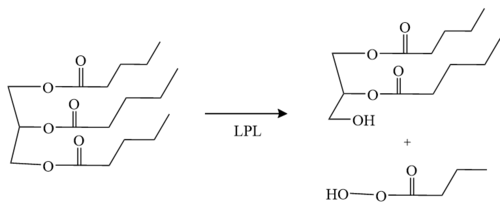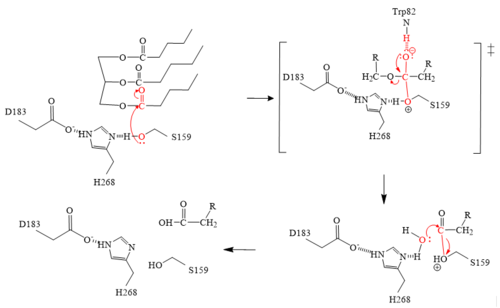User:Hannah Wright/Sandbox 1
From Proteopedia
(Difference between revisions)
| Line 9: | Line 9: | ||
'''Figure 1:''' Conversion of triglyceride to diglyceride by LPL. | '''Figure 1:''' Conversion of triglyceride to diglyceride by LPL. | ||
| - | LPL was identified more than 60 years ago and studied by biochemists and physiologists intensely since. It wasn’t until recently that LPL’s detailed structure was determined due to LPL’s hydrolase domain susceptibility to unfolding. LMF1 and GPIHBP1, '''glycosylphosphatidylinositol-anchored high-density lipoprotein–binding protein 1''' , were discovered to be required for proper folding and enzymatic activity of LPL. LMF1,''' lipase maturation factor 1''', is a chaperone protein that is responsible for proper folding and secretion of LPL. Through the use of X-ray crystallography, it was also discovered that LPL is a monomer rather than the previously believed homodimer. | + | LPL was identified more than 60 years ago and studied by biochemists and physiologists intensely since. It wasn’t until recently that LPL’s detailed structure was determined due to LPL’s hydrolase domain susceptibility to unfolding. LMF1 and GPIHBP1, '''glycosylphosphatidylinositol-anchored high-density lipoprotein–binding protein 1''' , were discovered to be required for proper folding and enzymatic activity of LPL. LMF1,''' lipase maturation factor 1''', is a chaperone protein that is responsible for proper folding and secretion of LPL. Through the use of X-ray crystallography, it was also discovered that LPL is a monomer rather than the previously believed homodimer <ref name="Birrane">PMID:30559189</ref>. |
</div> | </div> | ||
===Function=== | ===Function=== | ||
| - | LPL is located within the interstitial space independently and remains stranded there if not acted upon by GPIHBP1. GPIHBP1 then captures LPL in the interstitial spaces and shuttles it across endothelial cells into the capillary lumen. Once in the capillaries, the LPL-GPIHBP1 complex catalyzes the breakdown of triglycerides in the blood. In doing so, it prevents high levels of triglycerides in the plasma to provide nutrients for vital tissues. | + | LPL is located within the interstitial space independently and remains stranded there if not acted upon by GPIHBP1. GPIHBP1 then captures LPL in the interstitial spaces and shuttles it across endothelial cells into the capillary lumen. Once in the capillaries, the LPL-GPIHBP1 complex catalyzes the breakdown of triglycerides in the blood. In doing so, it prevents high levels of triglycerides in the plasma to provide nutrients for vital tissues <ref name="Birrane">PMID:30559189</ref>. |
===Significance=== | ===Significance=== | ||
Lipoprotein lipase deficiency leads to [http://.en.wikipedia.org/wiki/Hypertriglyceridemia hypertriglyceridemia] (elevated levels of triglycerides in the blood) also known as chylomicronemia. This can go on to increase insulin resistance and the risk of obesity. | Lipoprotein lipase deficiency leads to [http://.en.wikipedia.org/wiki/Hypertriglyceridemia hypertriglyceridemia] (elevated levels of triglycerides in the blood) also known as chylomicronemia. This can go on to increase insulin resistance and the risk of obesity. | ||
| Line 28: | Line 28: | ||
The N-terminus of LPL is made up of 6 α-helices and 10 β-strands known as the <scene name='87/877603/A-b_domain/1'>N-terminal α/β-hydrolase domain</scene>. Additionally, α/β hydrolase harbors the catalytic triad<ref name="Wong">PMID:8144612</ref>. | The N-terminus of LPL is made up of 6 α-helices and 10 β-strands known as the <scene name='87/877603/A-b_domain/1'>N-terminal α/β-hydrolase domain</scene>. Additionally, α/β hydrolase harbors the catalytic triad<ref name="Wong">PMID:8144612</ref>. | ||
====C-terminus of LPL==== | ====C-terminus of LPL==== | ||
| - | The C-terminus of LPL consists of 12 β-sheets and is known as the <scene name='87/877603/B-domain/2'>C-terminal flattened β-barrel domain</scene>. The β-sheets are interacting giving a shape that resembles an elongated cylinder or barrel. | + | The C-terminus of LPL consists of 12 β-sheets and is known as the <scene name='87/877603/B-domain/2'>C-terminal flattened β-barrel domain</scene>. The β-sheets are interacting giving a shape that resembles an elongated cylinder or barrel<ref name="Wong">PMID:8144612</ref>. |
====Interaction of LPL and GPIHBP1==== | ====Interaction of LPL and GPIHBP1==== | ||
| - | GPIHBP1’s LU domain interacts with LPL’s C-terminal domain via <scene name='87/877603/Lpl_gpihb1_interaction/3'>hydrophobic interactions</scene>. This is largely due to the hydrophobic effect and stabilization. The acidic N-terminal domain of GPIHBP1 (residues 21–61) is disordered and not visible in the structure, which is presumably due to dynamic interaction with the large basic patch on the LPL. | + | GPIHBP1’s LU domain interacts with LPL’s C-terminal domain via <scene name='87/877603/Lpl_gpihb1_interaction/3'>hydrophobic interactions</scene>. This is largely due to the hydrophobic effect and stabilization. The acidic N-terminal domain of GPIHBP1 (residues 21–61) is disordered and not visible in the structure, which is presumably due to dynamic interaction with the large basic patch on the LPL<ref name="Birrane">PMID:30559189</ref>. |
====Calcium Ion Coordination==== | ====Calcium Ion Coordination==== | ||
The <scene name='87/877636/Calcium_ion_coordination/1'>calcium ion</scene> has been shown to convert inactive LPL to the active dimer form. The calcium ion is coordinated by residues A194, R197, S199, D201, and D202. Mutations in the coordinating residues can give rise to detrimental metabolic diseases. The crystal structures of LPL revealed that the carboxylic acid side chain of D201 significantly aids in the coordination of LPL with the calcium ion. If D201 is mutated to a valine, for example, LPL can no longer fold correctly, and thus, LPL secretion from cells is inhibited due to the loss of the carboxylic acid side chain <ref name="Birrane">PMID:30559189</ref>. | The <scene name='87/877636/Calcium_ion_coordination/1'>calcium ion</scene> has been shown to convert inactive LPL to the active dimer form. The calcium ion is coordinated by residues A194, R197, S199, D201, and D202. Mutations in the coordinating residues can give rise to detrimental metabolic diseases. The crystal structures of LPL revealed that the carboxylic acid side chain of D201 significantly aids in the coordination of LPL with the calcium ion. If D201 is mutated to a valine, for example, LPL can no longer fold correctly, and thus, LPL secretion from cells is inhibited due to the loss of the carboxylic acid side chain <ref name="Birrane">PMID:30559189</ref>. | ||
Revision as of 01:36, 27 April 2021
Lipoprotein Lipase (LPL) complexed with GPIHBP1
| |||||||||||
References
- ↑ 1.00 1.01 1.02 1.03 1.04 1.05 1.06 1.07 1.08 1.09 1.10 Birrane G, Beigneux AP, Dwyer B, Strack-Logue B, Kristensen KK, Francone OL, Fong LG, Mertens HDT, Pan CQ, Ploug M, Young SG, Meiyappan M. Structure of the lipoprotein lipase-GPIHBP1 complex that mediates plasma triglyceride hydrolysis. Proc Natl Acad Sci U S A. 2018 Dec 17. pii: 1817984116. doi:, 10.1073/pnas.1817984116. PMID:30559189 doi:http://dx.doi.org/10.1073/pnas.1817984116
- ↑ 2.0 2.1 Wong H, Davis RC, Thuren T, Goers JW, Nikazy J, Waite M, Schotz MC. Lipoprotein lipase domain function. J Biol Chem. 1994 Apr 8;269(14):10319-23. PMID:8144612
- ↑ Arora R, Nimonkar AV, Baird D, Wang C, Chiu CH, Horton PA, Hanrahan S, Cubbon R, Weldon S, Tschantz WR, Mueller S, Brunner R, Lehr P, Meier P, Ottl J, Voznesensky A, Pandey P, Smith TM, Stojanovic A, Flyer A, Benson TE, Romanowski MJ, Trauger JW. Structure of lipoprotein lipase in complex with GPIHBP1. Proc Natl Acad Sci U S A. 2019 May 21;116(21):10360-10365. doi:, 10.1073/pnas.1820171116. Epub 2019 May 9. PMID:31072929 doi:http://dx.doi.org/10.1073/pnas.1820171116
- ↑ 4.0 4.1 Falko JM. Familial Chylomicronemia Syndrome: A Clinical Guide For Endocrinologists. Endocr Pract. 2018 Aug;24(8):756-763. doi: 10.4158/EP-2018-0157. PMID:30183397 doi:http://dx.doi.org/10.4158/EP-2018-0157
Student/Contributors
- Ashrey Burley
- Allison Welz
- Hannah Wright


